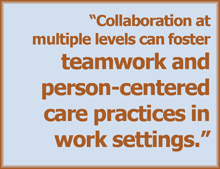Synopsis
A partnership was formed between a New York City nursing home union and 40 nursing homes to help implement "person-centered care" at the facilities. Results showed an improvement in quality of life, with residents gaining more autonomy and privacy and many employees experiencing greater job satisfaction.
 The Issue
The Issue
The traditional nursing home model relies on a top-down structure where frontline staff have little self-sufficiency to perform work and residents are not treated as unique individuals. Person-centered care is meant to increase the privacy and independence of residents by improving the quality of treatment and creating a more homelike environment. Because person-centered care directly affects the way frontline staff work, all nursing home employees must be fully engaged in adapting to the new model. This study examined two New York City nursing homes with unionized workers to see if the union and the nursing homes could work together to effect change, and to determine the time and resources that would be required.
Key Findings
- Giving residents' more choice in their daily lives, such as when they bathe, wake up in the morning, and take their meals, is central to person-centered care. By respecting residents' preferences, the staff at both nursing homes experienced fewer struggles with residents.
- After the changes, staff reported "pitching in" to do tasks outside their specific job requirements (and having this work reinforced by positive feedback from residents and extra help from other workers), having their voices heard and respected, and seeing improved teamwork among colleagues.
- Person-centered care practices allowed for more self-direction by staff. The structural changes implemented included the designation of a neighborhood coordinator within each unit to oversee changes and the shifting of management oversight over some areas to those coordinators.
- Implementing person-centered care requires a dedication of resources. This includes payment for training, as well as filling positions during training times. Day-long conferences that offered policy discussion and formal instruction cost up to $350,000. Onsite training was approximately $300 for each of the more than 7,000 workers.
- Flexibility is required. Employees were given the opportunity to work outside their normal domains. Some employees seemed satisfied with the new tasks, while others were not. The union supported person-centered care while simultaneously protecting members who felt that changes threatened their contractual safeguards.
Addressing the Problem
The labor–management partnership examined in this study appears to be a viable way to support "culture change" at nursing homes. First, the model linked the participating nursing homes in a "learning collaborative" that provided important training resources otherwise unavailable to a single facility. Second, the union's participation helped workers feel secure that their jobs would evolve in a deliberate fashion, and that their voices would be heard. Challenges that will require further research include: building trust between newly created roles, like neighborhood coordinators, and department heads; encouraging staff buy-in of person-centered care; and balancing staffing and responsibilities across work shifts.
About the Study
The authors focused on a partnership between a New York City–based nursing home union and 40 nonprofit nursing homes. The study was designed to reveal whether and how the labor–management partnership supported person-centered care and to identify future challenges. In both nursing homes, the union represented all frontline workers: housekeeping, food service, and nursing personnel, including certified nursing assistants and registered nurses. The authors gathered data from archival sources, observations, interviews, and field research at the two homes. All frontline staff were interviewed, from the chief executive officers to housekeepers, totaling 71 employees between the two homes. This study was supported by a grant from The Commonwealth Fund.
The Bottom Line
Creating a partnership between labor unions and nursing homes can be an effective way to implement person-centered care, leading to improved conditions for residents and greater job satisfaction among all levels of staff.


